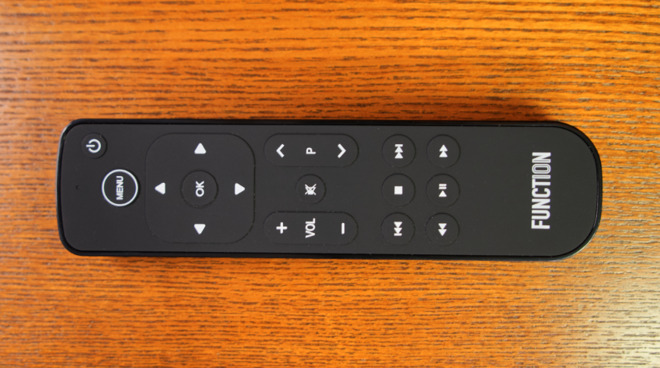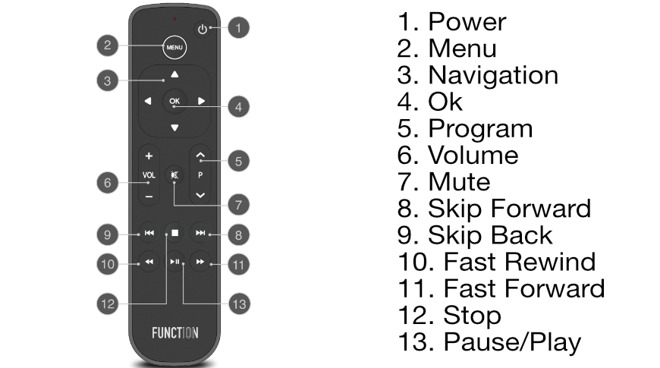Review: Button Remote for Apple TV makes entertainment simple again
The Button Remote for Apple TV by Function 101 is a simple IR remote that brings physical controls to the Apple TV experience.

The Button Remote for Apple TV
The Siri Remote that comes bundled with the Apple TV 4K is one of Apple's more controversial products. It is flat, symmetrical, and finicky with its trackpad interface. The Button Remote by Function 101 hopes to solve these problems.
Many aspects of the Siri Remote center around special software functions or gaming. The trackpad doubles as a virtual joystick for games, the play/pause button a select button for simple controls. The remote itself has accelerometers, so the remote can be swung like a bat for a Nintendo Wii-like gaming experience.
On top of that there are gestures, edge-clicks, tap vs press functions, and Siri voice commands that make this remote control very complex. Users who want to watch TV are easily overwhelmed by the device, especially if they have limited cognitive skills or learning impairments.
Each Apple TV remote has a unique function set
If the Siri Remote sounds like a nightmare and you want to turn on your TV and watch a movie at a reasonable volume, the Button Remote has you covered. As the name implies, there are plenty of buttons, 18 of them in fact, and they are all tactile and clicky.
This remote is instantly familiar to anyone who has ever used a TV before, thick black plastic casing with rubber buttons. The layout places navigation controls at the top, volume and auxiliary controls in the middle, and playback controls at the bottom.
The Button Remote comes programmed to for Samsung TVs out of the box. This means the power button and volume rocker will control your TV with no further setup. The setup instructions for TV and soundbar control can be found in the Function 101 FAQ page.
Unlike the Siri Remote, the Button Remote uses IR to communicate with the Apple TV, so it must have direct line-of-sight to control it. There must be line-of-sight for the TV and soundbar being handled by the remote as well.
There are a few functions missing from the Button Remote that some users are likely to notice. There is no "TV" button, which is used to return to the TV app, open the task switcher, and open the Control Center. Without that button you cannot switch users on the fly or access tvOS 14 features like HomeKit cameras.
Siri is absent as well, meaning text entry is laborious and there is no access to any Siri functions across the system. Users who are replacing their Siri Remote entirely may have to fall back to their iPhone Remote app or the Siri Remote to perform some tasks. This shouldn't be an issue for users who do not access more advanced functionality.
All of the Apple TV specific buttons work without any programming, so even if you move between rooms and Apple TV boxes, the remote will always work. The programming for volume and power will have to change if you use different TV brands, though.

Button Remote buttons
The features the Button Remote lacks are the primary purpose of the device. Not only is the device cheaper for these missing technologies, its much more straightforward for the user.
Only one significant anomaly exists for the Button Remote; the Program rocker. It serves no purpose, though the manufacturer says that a list of compatible apps will be added to the website FAQ in the future. The "P" rocker is available for apps to use as an additional input. Think cable providers being able to change channels with it inside the Apple TV app. Otherwise, it is only used when programming the remote for different TVs, which is strange given its placement.
Do not buy if the idea of losing Siri or Control Center functionality is a total turn off. Those with complex HomeKit or AirPlay setups will sorely miss the Siri Remote. Though, these functions can be reached within the TV Remote app on iPhone and iPad.
Pros
Rating: 3.5 out of 5

The Button Remote for Apple TV
The Siri Remote that comes bundled with the Apple TV 4K is one of Apple's more controversial products. It is flat, symmetrical, and finicky with its trackpad interface. The Button Remote by Function 101 hopes to solve these problems.
The Siri Remote
To understand why a product like the Button Remote exists, first look at the Siri Remote. Apple has attempted to create a minimalistic remote to control all interactions. There are plenty of features packed into this remote, but most users won't know or care that they exist.Many aspects of the Siri Remote center around special software functions or gaming. The trackpad doubles as a virtual joystick for games, the play/pause button a select button for simple controls. The remote itself has accelerometers, so the remote can be swung like a bat for a Nintendo Wii-like gaming experience.
On top of that there are gestures, edge-clicks, tap vs press functions, and Siri voice commands that make this remote control very complex. Users who want to watch TV are easily overwhelmed by the device, especially if they have limited cognitive skills or learning impairments.
The Button Remote

Each Apple TV remote has a unique function set
If the Siri Remote sounds like a nightmare and you want to turn on your TV and watch a movie at a reasonable volume, the Button Remote has you covered. As the name implies, there are plenty of buttons, 18 of them in fact, and they are all tactile and clicky.
This remote is instantly familiar to anyone who has ever used a TV before, thick black plastic casing with rubber buttons. The layout places navigation controls at the top, volume and auxiliary controls in the middle, and playback controls at the bottom.
The Button Remote comes programmed to for Samsung TVs out of the box. This means the power button and volume rocker will control your TV with no further setup. The setup instructions for TV and soundbar control can be found in the Function 101 FAQ page.
Unlike the Siri Remote, the Button Remote uses IR to communicate with the Apple TV, so it must have direct line-of-sight to control it. There must be line-of-sight for the TV and soundbar being handled by the remote as well.
There are a few functions missing from the Button Remote that some users are likely to notice. There is no "TV" button, which is used to return to the TV app, open the task switcher, and open the Control Center. Without that button you cannot switch users on the fly or access tvOS 14 features like HomeKit cameras.
Siri is absent as well, meaning text entry is laborious and there is no access to any Siri functions across the system. Users who are replacing their Siri Remote entirely may have to fall back to their iPhone Remote app or the Siri Remote to perform some tasks. This shouldn't be an issue for users who do not access more advanced functionality.
All of the Apple TV specific buttons work without any programming, so even if you move between rooms and Apple TV boxes, the remote will always work. The programming for volume and power will have to change if you use different TV brands, though.

Button Remote buttons
The features the Button Remote lacks are the primary purpose of the device. Not only is the device cheaper for these missing technologies, its much more straightforward for the user.
Only one significant anomaly exists for the Button Remote; the Program rocker. It serves no purpose, though the manufacturer says that a list of compatible apps will be added to the website FAQ in the future. The "P" rocker is available for apps to use as an additional input. Think cable providers being able to change channels with it inside the Apple TV app. Otherwise, it is only used when programming the remote for different TVs, which is strange given its placement.
Should you buy the Button Remote?
If the included Siri Remote is frustrating or you desire a remote with physical buttons, then the Button Remote is a perfect choice. Customers seeking an alternative remote for elderly family members or those with disabilities that make using a trackpad or tiny remote difficult, then the Button Remote is also a great choice.Do not buy if the idea of losing Siri or Control Center functionality is a total turn off. Those with complex HomeKit or AirPlay setups will sorely miss the Siri Remote. Though, these functions can be reached within the TV Remote app on iPhone and iPad.
Pros
- Physical Buttons
- Simple to use and set up
- Easy to grip
- Requires batteries
- Program rocker basically useless despite prominent placement
- No Siri or TV buttons
Rating: 3.5 out of 5

Comments
The other useful thing it has is a Power button, which works with our 2008 Samsung not-so-smart TV (which has a nice sort of “retro” look today). The Apple remote (via the tv) turns the power on and off for two other, newer TVs in our household, but not the older one.
The “P” rocker is an odd choice — it doesn’t work with the YouTube TV app yet, but if and when it does, it will be for changing channels when watching live television, so why not label it “CH” like every other English-language remote in existence?
This that true?? I had no idea. Is there a free app I can download to experience this?
I'm not sure this means what you think it means AI. I think you mean if they have cognitive impairment! Or perhaps are old, or young.
https://drive.google.com/file/d/1XgI-BhKfO6KoWCdRM7yNLBFJyuPIwwKv/view
The directions are here:
https://function101.com/pages/button-remote-for-apple-tv-support
• that Apple TV remote...
• the puck mouse, for historic reasons (this should never have gotten to customers; everyone including Jobs failed here)
• the mice since then where the body/base is the button mechanism, causing usage clumsiness, especially with lifting the mouse to relocate it when click-dragging (no, those lame grip zones suck)
• the first Magic Trackpad where the button mechanism is the rubber feet up front that get caught under the body and stick
• iOS 7 UI redesign <- this is more like what I’d call a fireable offense
• thinness/minimalist obsession, causing ergonomic issues, thermal issues, reduction in convenience features, etc. such as:
• iPhones that are so thin and slippery that a case is required to feel comfortable and stable in the hand
• removal of buttons leading to further reliance on gestures
• conflicting gestures in iOS
• material waste (mostly because of sealed rechargeable batteries) and servicing difficulty...
... I could keep going. It all adds up to a lot of really bad design, in a company that is famous for “insanely great design”. Ive was better off doing hardware design only, when managed by people who appreciated customer-friendly details and a need for serious computing power. Giving him authority over GUI design, and basically total authority in design in general, was a major mistake.